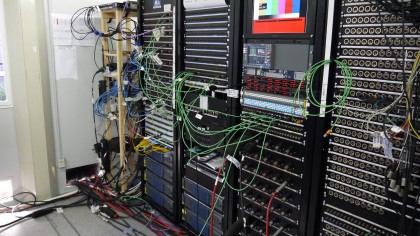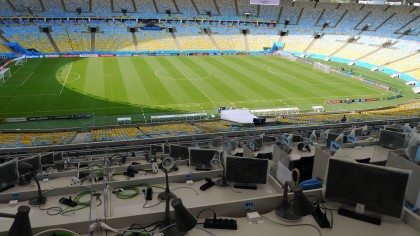Shooting for the future: the hidden challenge of the World Cup final
Behind the scenes at the biggest game in football

Today one of the most famous stadia in the world – the Maracana in Rio de Janeiro, Brazil – hosts the biggest game in football, the World Cup final.
This significance of this event isn't just about the action that's on the pitch; from the secrecy of past lurking beneath the surface to landmark advances in technology attached, this game has a huge significance that many won't even notice.
From the comfort of your sofa, it seems like any other match, with a few cameras beaming pictures into your lounge in a very similar way to the weekly sporting action.

But in reality it's a huge endeavour which requires hundreds of staff working just to show you 22 sweaty men sprinting around a patch of grass.
"[Broadcasting the World Cup final] is different to a run of the mill football match, because there we're only servicing one customer, maybe two if it's split," said Jeff Coleman, technology manager for Host Broadcast Services (HBS), which provides the TV pictures to the world.
"Here we're servicing the whole planet, and we've got the world's broadcasters here in the compound and at the International Broadcast Centre."

Most will take the main feed from HBS, connecting into a huge buzzing server to get pictures from dozens of cameras and a helicopter – 40 cameras in all, which this year will include Ultra HD (4K) recording for the first time too, all to bring the World Cup final from the iconic Maracana to millions of global eyeballs.
Sign up for breaking news, reviews, opinion, top tech deals, and more.
The past supporting the future
This historic stadium looks like many others, a cathedral of plastic seating and clean walkways befitting a modern football ground. But underneath this façade live the old terraces, once home the largest attendance for a single football match: the 1950 World Cup final, when Brazil last hosted the tournament.

These hallowed platforms are being used for this year's final too: they provide the ground over which hundreds of metres of cabling is run below the current stands (stumbled upon by engineers one day who realised the logistical potential of the space), playing a vital role in helping run one of the most complex broadcasting events.
It feels sad to such an historic part of work football reduced to being a cable dumping ground – but at the same time there's a sense of continuity that such an iconic part of the old stadium (which couldn't have been used on health and safety grounds) is still being used in some capacity to entertain millions across the globe.
The Cup in numbers
When walking around the Maracana, even when empty save for a few engineers strolling around, there's an overwhelming sense of the enormous job ahead of this crucial game, one that simply cannot be subject to power outages or other catastrophes.
The commentator you hear will be surrounded by 149 doing the same thing in a special media zone, each with power leads, internet connection, lamps and monitors to allow them to beam across the globe.

But problems do arise – for instance, there was a fire in one of the centres in a warm up game – so how do broadcasters cope?
"Nobody noticed [that we had a fire]," said Coleman. "We always have a plan B so that if something catastrophic happens I can get pictures to the world.
"For instance, we have an incorruptible power supply; we've got four generators running but even if three fail we've got enough power to service what we need.
"In fact we only need one camera at the minimum. As long as we've got one, with audio and commentary, you wouldn't really know the difference."
The key is in the redundancy, with backup cameras on the main platforms surrounded by backup cables, making sure there's always something being beamed out from the match.
"Seriously, if we lose one camera out of 40 it would be tough to see it's gone," said Coleman.
But there's an extra challenge here: one where the next generation of TV viewing is being experimentedon, and doing so at one of the most critical sporting events in the world presents its own challenges too, so we took a look to see how that can fit into this well-oiled machine.

Gareth has been part of the consumer technology world in a career spanning three decades. He started life as a staff writer on the fledgling TechRadar, and has grew with the site (primarily as phones, tablets and wearables editor) until becoming Global Editor in Chief in 2018. Gareth has written over 4,000 articles for TechRadar, has contributed expert insight to a number of other publications, chaired panels on zeitgeist technologies, presented at the Gadget Show Live as well as representing the brand on TV and radio for multiple channels including Sky, BBC, ITV and Al-Jazeera. Passionate about fitness, he can bore anyone rigid about stress management, sleep tracking, heart rate variance as well as bemoaning something about the latest iPhone, Galaxy or OLED TV.